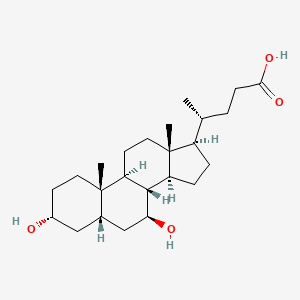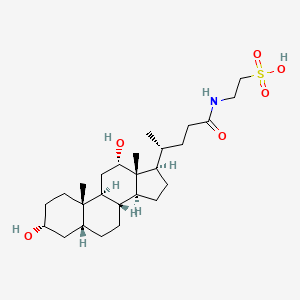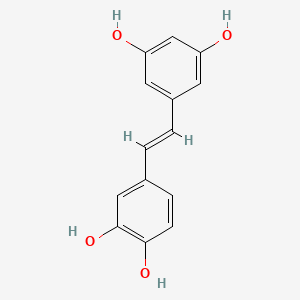
|
Ursodeoxycholic acid |
Ursodeoxycholic acid is a lipid of Sterol Lipids (ST) class. Ursodeoxycholic acid is associated with abnormalities such as Liver diseases, Cirrhosis, Hypertension, Portal, Cholestatic liver disease and Cholangitis, Sclerosing. The involved functions are known as protein expression, Fibrosis, Apoptosis, Metabolic Inhibition and Signal Transduction. Ursodeoxycholic acid often locates in Membrane, Clone, Tissue membrane, Protoplasm and Hepatic. The associated genes with Ursodeoxycholic acid are ABCC2 gene, ABCB4 gene, IMPACT gene, Alleles and PTGS2 wt Allele. The related lipids are Micelles, Steroids, cholanic acid, glycoursodeoxycholic acid and taurolithocholic acid 3-sulfate. The related experimental models are Disease model. |
3362 |

|
Taurodeoxycholic acid |
Taurodeoxycholic acid is a lipid of Sterol Lipids (ST) class. Taurodeoxycholic acid is associated with abnormalities such as Ischemia and Wiskott-Aldrich Syndrome. The involved functions are known as Cell Proliferation, Transcriptional Activation, Phosphorylation, Anabolism and Biochemical Pathway. Taurodeoxycholic acid often locates in Body tissue, Epithelium, Blood, Mucous Membrane and Hepatic. The associated genes with Taurodeoxycholic acid are NOX5 gene, GPBAR1 gene, NR1H4 gene and SLC33A1 gene. The related lipids are cholanic acid, taurolithocholic acid 3-sulfate, Sterols, 7-dehydrocholesterol and tauromuricholic acid. |
352 |

|
piceatannol |
piceatannol is a lipid of Polyketides (PK) class. Piceatannol is associated with abnormalities such as Infection, Pneumonia, BOSLEY-SALIH-ALORAINY SYNDROME, Morphologically altered structure and Renal tubular disorder. The involved functions are known as Stimulus, Inflammatory Response, Host defense, Phagocytosis and Uptake. Piceatannol often locates in soluble, Protoplasm, Back, Body tissue and Tissue membrane. The associated genes with piceatannol are Human gene, SELPLG gene, ICAM1 gene, CD1D gene and LAMP1 gene. The related lipids are Promega, Fatty Acids, Butanols, Phosphatidic Acid and phosphatidylethanol. The related experimental models are Mouse Model. |
689 |


